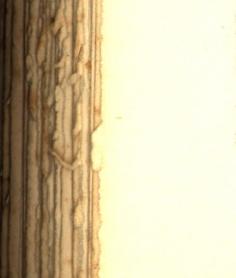282 DOGS AND ALL ABOUT THEM
pure pearly white, with bright rich chestnut or ruby red markings evenly distributed in large patches. The ears and cheeks should be red, with a blaze of white extending from the nose up the forehead, and
ending between the ears in a crescentic curve. In the centre of this blaze at the top of the forehead there should be a clear " spot " of red, of the size of a sixpence. Tan ticks on the fore-legs and on the white muzzle are desirable. The Tricolour should in part have the tan of the Black and Tan, with markings like the Blenheim in black instead of red on a pearly-white ground. The ears and under the tail should also be lined with tan. The Tricolour has no" spot," that beauty being peculiarly the property of the Blenheim. The All Red King Charles is known by the name of " Ruby Spaniel " ; the colour of the nose is black. The points of the " Ruby " are the same as those of the " Black and Tan," differing only in colour.
The King Charles variety used to consist of black and tan and black and white Spaniels, and it is thought that by the inter-breeding of the two specimens the Tricolour was produced. The colour of the King Charles now is a glossy black with rich mahogany tan spots over the eyes and on the cheeks. There should also be some tan on the legs and under the tail.
The Prince Charles, or Tricolour, should have a pearly-white ground with glossy black markings evenly distributed over the body in patches. The ears should be lined with tan ; tan must also be seen over the eyes, and some on the cheeks. Under the tail also tan must appear.
The Blenheim must also have a pearly-white ground with bright rich chestnut or ruby red markings evenly distributed in patches over the body. The ears and cheeks must be red, and a white blaze should stretch from the nose to the forehead and thence in a curve between the ears. In the middle of the forehead there should be, on the white blaze, a clear red spot
h ' f This is called the " Blenheim
spot," which, as well as the profuse mane, adds greatly to the beauty of this particular Toy Spaniel. Unfortunately, in a litter of Blenheims the spot is often wanting.
The Ruby Spaniel is of one colour, a rich, unbroken red. The nose is black. There are now some very beautiful specimens of Ruby Spaniels, but it is only within the last quarter of
THE KING CHARLES SPANIELS 283
a century that this variety has existed. It seems to have originally appeared in a litter of King Charles puppies, when it was looked upon as a freak of nature, taking for its entire colour only the tan markings and losing the black ground.
The different varieties of Toy Spaniels have been so much interbred that a litter has been reputed to contain the four kinds, but this would be of very rare occurrence. The Blenheim is now often crossed with the Tricolour, when the litter consist of puppies quite true to the two types. The crossing of the King Charles with the Ruby is also attended with very good results, the tan markings on the King Charles becoming very bright and the colour of the Ruby also being improved. Neither of these specimens should be crossed with either the Blenheim or the Tricolour, as white must not appear in either the King Charles or the Ruby Spaniel.
It is regretted by some of the admirers of these dogs that custom has ordained that their tails should be docked. As portrayed in early pictures of the King Charles and the Blenheim varieties, the tails are long, well flagged, and inclined to curve gracefully over the back, and in none of the pictures of the supposed ancestors of our present Toy Spaniels-even so recent as those painted by Sir Edwin Landseer-do we find an absence of the long tail.
If left intact, the tail would take two or three years to attain perfection, but the same may be said of the dog generally, which improves very much with age, and is not at its best until it is three years old, and even then continues to improve.
Although the Toy Spaniels are unquestionably true aristocrats by nature, birth, and breeding, and are most at home in a drawing-room or on a well-kept lawn, they are by no means deficient in sporting proclivities, and, in spite of their short noses, their scent is very keen. They thoroughly enjoy a good scamper, and are all the better for not being too much pampered. They are very good house-dogs, intelligent and affectionate, and have sympathetic, coaxing little ways. One point in their favour is the fact that they are not noisy,

